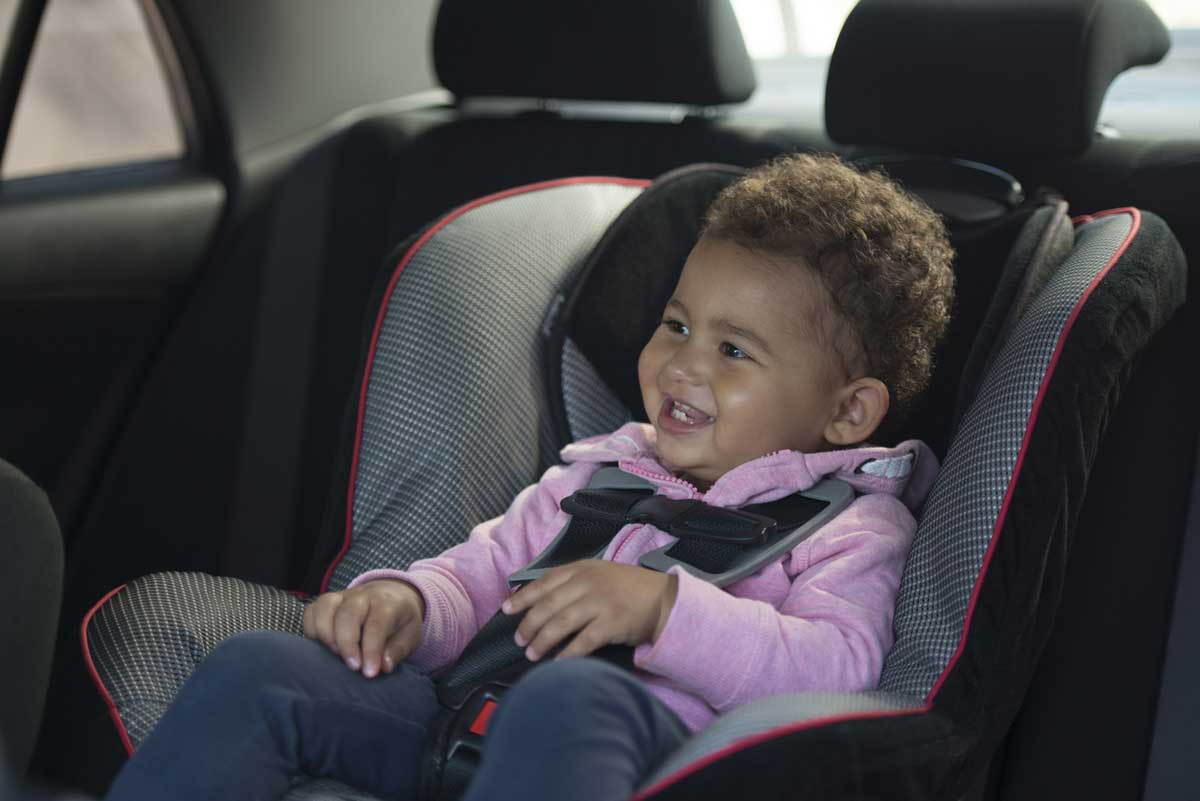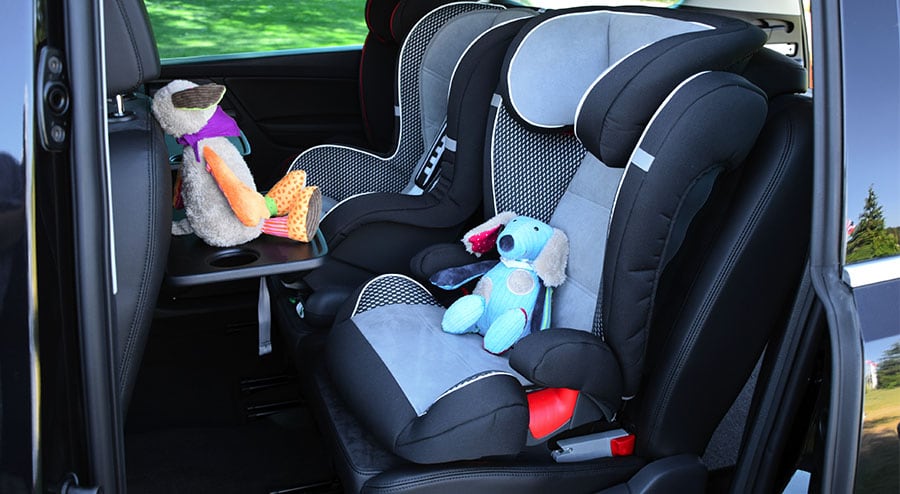When discussing child restraint laws for travel in motor vehicles, we commonly refer to rules that apply to people who are under a certain age. In some cases, this involves rules and regulations about child safety seats and the need for booster seats. In others, it refers to some specific age when children need to use the back seat or mandatory safety belts.
For people transporting children over state lines, there are some good news and some bad news. The bad news is that state legislation on the standard and quality of car seats and ages vary significantly and that there is no federally enforced law on the matter. If you wish to drive your kids from coast to coast and be sure you are not breaking the law you will have to inform yourself about every state law on your route.

The good news is that all state legislation is gauged towards being common sense and having the best interest of the child in mind, which is also the main concern of every police officer in every state that may pull you over. If your child is safe, driving in the back seat and properly secured for their age you will have little to worry when it comes to the law.
It is a common misconception that some state laws are just made as for the budget to be filled with ticket money, as most people are usually on the receiving end of the ticket, but no legislator or police officer like to be across the car window from an agitated parent, just wanting to have a nice road trip with their family. If you seem to have common sense and drive your children in a safe way with them safely secured, you will rarely have an issue with any officer or judge, if it were ever to come to that.
General Safety Terms
General child-passenger safety refers to the security of your child in their seat, whether it is a safety seat with a child restraint harness, a belt-positioning booster seat, or just the vehicle’s safety belts and the position of the child in the rear seat of the vehicle. This is dependent on the age of the child, the specifics of the vehicle and the requirements of the car seat your child is using. As a rule of thumb, you should have your safety belt on at all times while driving, as should all the passengers—no matter the age.

For children, there are four types of safety seats that are age and size (and weight limit) dependent and this age and size is usually represented in the state laws across the country. The youngest of children should be in the rear-facing car seats that are attached to a lap belt, toddlers and preschoolers should be in a front-facing car seat with a child restraint harness that has a latch system with the motor vehicle and older children who can’t yet use the car’s own belts properly should have a booster seat or a safety vest.
Almost all states have a requirement and/or clause for age and size, meaning that your child just needs to fulfill one of the requirements to be eligible to use the correct seat for the motor vehicle, preventing the law from forcing your child to be unsafe just to fulfill the legal requirements. For most children, both requirements will match almost all of the time, but your primary concerns should be the safety of your child and the law will follow you.
It is both the recommendation from the American Association of Pediatrics and State law in most US states for children under the age of two to be in a rear-facing car seat and not a forward-facing car seat. As most parents know, babies and small children tend to be top heavy as we are all born with large heads compared to out body. Because of this fact, it is good for the child to be in a rear-facing car seat, as during an accident that will reduce the stress to the baby’s head and spine, making it just fall into a seat instead of pulling forward.
Children heavier than 40 pounds and longer than 40 inches, which usually means around two years old, should change to a front-facing safety seat that has a 5-point harness and stay in that seat until they are around eight or nine years old. If your child reaches this size before their second birthday, don’t worry, as the law accepts that larger children can travel in front-facing safety seats.
If your child is over two years of age, but is not yet over the weight and height limit, consider keeping it in the rear-facing model for a little while longer. There are convertible models on the market that can be used as both rear facing and front facing and if you are unsure which see most use from your child you may want to consider this one.
For older children—meaning kids that are over eight years old—the law in most states is more focused in the proper use of the safety belt than on any other requirements, and so should you. When your child is using the booster seat make sure that they are secured, having the lap belt over their thighs or hips and the shoulder belt straight over their chest, not touching the neck.

When your child can properly use the seat belt unassisted, it is fine to forgo the booster seat. Still, all children should sit in the back seat at least until the age of 15 and all passengers, no matter the age or the specific law, should wear seat belts at all time while in the car.
Traveling Guidelines
You should always be aware of the state and federal laws that apply to you. They are not only useful guidelines in conducting yourself in the most appropriate way but will prevent you from enduring any penalties from the law that you don’t need to endure. When you are traveling, you should be informed about the specific state legislation and give some leeway for specific laws to be stricter than the laws in your home state.
When making a travel plan, make sure that you have all of your licenses and documents, as well as documents for the children at hand at all times. If you have lost yours or your child’s documents, report that to the relevant authorities and refrain from traveling over state lines before you get new ones.
The guidelines we have mentioned above are meant to cover the strictest of laws in all states and if you follow them you will be fine, but you should always check the exact laws in all states in your route and confirm before taking a trip. Laws are amended all the time and there could be some specific changes.
Always use the safety seats as stated in the manufacturer manual and secure them safely at all times. If your child, or yourself, is uncomfortable, it is much better to take a break at a rest stop than to put anyone in danger. It is best for you to be an example for your children and wear a seatbelt at all times so that they would too. This is the best way to keep yourself safe and to install the habit of staying safe in traffic in your children.
State Specifics
What confuses most people, including those with an education in law or administration, is the jargon of the legislators in almost all parts of the world. As any other line of work, this job also has some specific words and sentence structures that seem odd for people not in the same line of work. The problem is that laws need to apply even to those who are not lawmakers and nobody should need to use a dictionary when trying to find out what kind of legislation applies to them.

For that reason, if you are following the overall rules stated above you will cover all the rules in all states, but it is important, if not amusing, to mention some state legislation that would have seemed strange to you if you didn’t know what to expect.
Multiple states, such as North Carolina and New Mexico, refer to seat belts as “child restraint systems” even for persons who are over the age of 16 and are oftentimes eligible to drive the vehicle themselves. This creates an illusion that a 17-year-old man who is 200 pounds heavy should be in a booster seat, which is funny to imagine but impossible to apply.
When you see this kind of language in state law, know that any elaborate system or device when refereeing to car seat laws is usually a fancy way to say seat belts and child seats, booster seats and rear-facing safety seats are referred to as such.
As usual, legislation of child-passenger safety is a mix of common sense, concerned communities and legislative language, but if you use the first one all other safety laws will usually come into place on their own. Seat belt laws are designed to help keep your family safe. Follow the rules and the law will always be on your side.
Sources
- https://www.willis.law/blog/2014/january/car-seats-and-child-safety-a-review-of-michigans
- https://www.which.co.uk/reviews/child-car-seats/article/child-car-seat-laws-uk-and-abroad/child-car-seat-laws-in-the-uk
- https://bestcarseathub.com/blog/car-seat-laws-for-children-in-california-for-this-coming-2017/
- https://www.tapinjury.com/news/2017/05/rhode-island-law-may-soon-require-rear-facing-car-seats-toddlers.html



